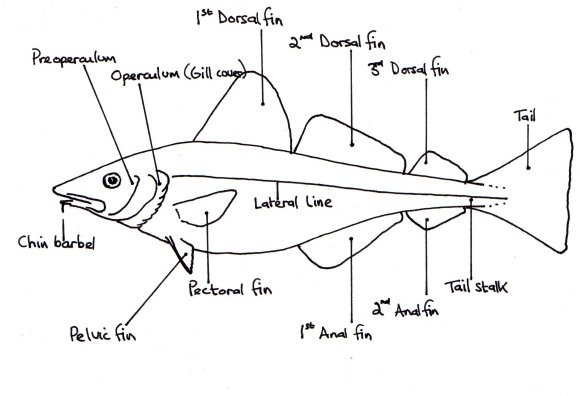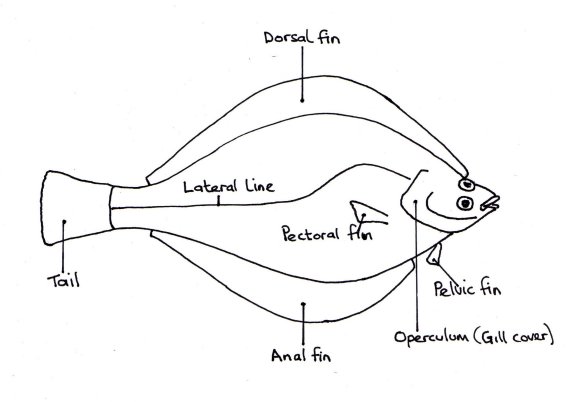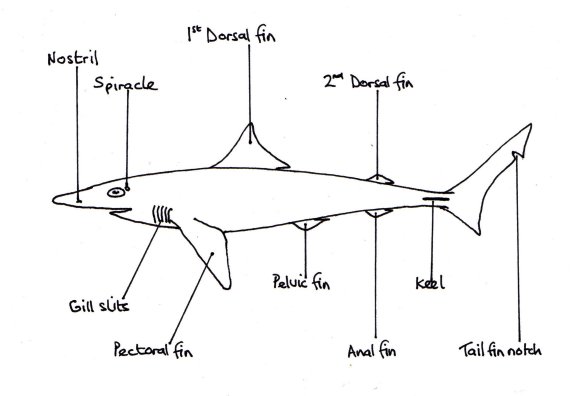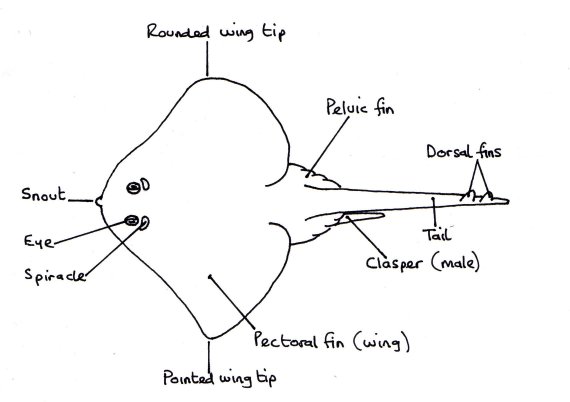MARINE FISH IDENTIFICATION
As with any science based factual piece of text, fish identification can be quite a 'dry' subject, except of course when you are handling the specimen in question. That said, for anglers, some rudimentary grasp of the subject is both necessary and satisfying. I think it's fair to say that most of us like to know what exactly it is we are catching. With some species the issue is never in question. Unfortunately, for others, the answers are not so clear cut. On top of this, visitors to the site have been asking for detailed information on the subject. I see no point in mixing the key identification points in amongst lots of flowery stuff just to make it a more interesting to read. It isn't supposed to be interesting. People don't want to be trawling through paragraph after paragraph picking the bones out of the thing. Clear concise facts with points of difference between the species in question and similar related species is the quick sure fire way of getting this particular job done.
On the marine side of things, climatic change, whether it is caused by global warming or part of some natural cycle is an established fact. Planktonic species normally found 500 miles to the south of Britain and Ireland are now turning up on our door step demonstrating an extensive northerly shift in the food web which is bound to bring with it fish hitherto not recorded off our coast. The press was full of such stories in the summer of 2008 when a Marlin and a Broadbill Swordfish were both washed up dead off the coast of South Wales. The Marlin, found at Saundersfoot, is arguably circumstantial evidence of that northerly shift, though they have been found here before as far north as Loch Long in Scotland. The Swordfish however isn't. They have been off our coast for years. It's just that they live offshore over deep water and need to be specifically fished for after dark. So the Marlin has not been included as a potential rod and line species here, but the Swordfish has, as it is probably just a matter of time before some dedicated angler, probably off the coast of south west Ireland, brings one ashore. And another likely candidate for the future is the European Barracuda, one of which was taken commercially within 6 miles of the Cornish coast in 2001.
In addition to these and countless other similar examples, there always has and always will be the occurrence of chance vagrants not only from latitudes to the north and to the south, but also from the other side of the Atlantic such as a Bermuda Chub recorded off the west coast of Ireland, and always of extra special interest, unusual deep water species normally only found well offshore way beyond angling reach. A few of these are recorded on rod and line, examples being the Blackfish and Opah. But not all of them. A lady called Val Fletcher fishing after dark from the beach at Skinningrove on the north east coast made one of the most unlikely catches ever when she winched in an 11 foot Oar Fish. This is the largest bony fish species in the world and one which is rare even over the sorts of depths it prefers along the edge of the continental shelf. Details are given of its identification because it has been caught on rod and line, though for reasons of claims procedure anomalies, it was not awarded official record status.
The dilemma this poses to the marine side of a fish identification project such as this is that with no physical boundaries at sea, it is difficult to know where exactly to draw the line in terms of cut off points. My initial thought was to use the British, Scottish, Welsh and Irish record fish lists as my species source. However, the problem there is that these lists are constantly being added to. Next I thought of expanding the geographical limits to take in those areas of sea to the south of us where the warmer water species are pushing up from, only to find that hitherto un-recorded species from even further afield are also finding themselves in British and Irish waters, one of which possibly with time will end up on an anglers hook. So, what I have done is combine the rod and line recorded species from the four previously mentioned national record lists as the foundation, and built around that a supporting cast of other species which could conceivably join them in the foreseeable future. On the freshwater side of things it is a little more clear cut and finite in that unless someone deliberately makes an introduction, then with the odd accidental exception of say some Salmon species taking the wrong route back from the sea, it isn't going to happen. So in that case, what you currently have is what get.
FISH TAXONOMY
Taxonomy is the scientists way of pigeon holing species (including fish) into similar groupings. It is a hierarchical system in that it starts in the case of fish with vertebrates, which is all animals that have vertebral back-bones, then continues on down incrementally until it reaches individual species which are given scientific names that say something about their place in the greater scheme of things. There is nothing to fear in any of this. Its rather like writing your home address in reverse. If someone from Australia asked where you lived, you wouldn't say for example 21 Cumberland Avenue. You'd say Britain, then England, and if the person was still interested, start refining it further to say southern England, then Kent, followed by Maidstone, and finally your road and house number. Fish classification is exactly the same. Instead of the United Kingdom, it's the Animal Kingdom. The next tag is Phylum, which in this case is Chordata (vertebrates) followed by Class. Fish belong to one of three classes - Agnathans (Hagfishes & Lampreys), Chondrichthyes (sharks & Rays), and Osteichthyes (bony fishes such as Bass, Cod, Roach and Rudd). This is then broken down into Orders such as Perciforms and Atheriniforms. Next comes Genera. The generic name is the first half of the two part scientific name such as Gadus (Cod) or Raja (Rays) terminating in the species tag which is the second part of the scientific name such as batis which again belongs to the Common Skate Raja batis. Scientific names are traditionally written in italics. So the fish Raja batis which is the Common Skate, belongs to the Genus Raja and Family Rajidae, and to the Class Chondrichthyes which are the cartilaginous sharks and rays.
Not all of this information is either relevant or necessary here. For our purposes the Family name and the two part scientific name giving Genus and specific epithet (personal tag) only will be given. The families dealt with here are as follows......
CLASS CHONDRICHTHYES
Cartilaginous fishes characterised by paired fins, jaws with teeth, no swim bladder, and reproduction by internal fertilization. This class sub divides into two units.
Bradyondonti - the Chimaeras and Rabbit Fishes
Chimaeridae – the Rabbit Fish
Elasmobranchi - the sharks and rays
Hexanchidae - the Six Gilled Shark.
Scyliorhinidae - the Dogfishes.
Sphyrnidae - the Hammerhead Sharks.
Isuridae - the Mackerel Sharks.
Alopiidae - the Thresher Sharks.
Carcharinidae - the Blue Shark and Tope.
Triakidae - the Smoothhounds.
Squaloidae - the Spiny Sharks.
Squatinidae - the Monkfishes.
Rhinobatidae - the Guitar Fishes.
Rajidae - the skates and rays.
Dasyatidae - the Stingrays.
Myliobatidae – the Eagle Rays.
Torpedinidae - the Electric Rays.
NOTE: In European freshwaters there are none.
CLASS OSTEICHTHYES
The bony fishes, which besides having a true bony skeleton in the adult stage, also have paired fins, a body typically covered with scales, and usually though not always possess a swim bladder.
Gadidae - the Cod family.
Serranidae - the Basses, Combers and Wreckfish.
Sparidae - the Sea Breams.
Bramidae - the Rays Breams.
Sciaenidae - the Corb and Meagre.
Labridae - the Wrasses.
Scombridae - the Mackerels and Tunnies.
Xiphiidae - the Swordfish.
Clupeidae - the Herring family.
Carangidae - the Scads and Jacks.
Belonidae - the Garfishes.
Scomberesocidae - the Skippers.
Mugilidae - the Grey Mullets.
Mullidae - the Red Mullets.
Triglidae - the gurnards.
Congridae - the Conger Eel.
Anguillidae - the Silver Eel.
Muraenidae - the Moray Eel.
Lophiidae - the Anglerfishes.
Zeidae - the John Dory.
Capronidae - the Boar Fish.
Molidae - the Sunfishes.
Lamprididae - the Opah.
Blenniidae - the Blennies.
Stichaeidae - Yarrell's Blenny.
Lumpenidae - the Snake Blenny.
Zoarcidae - the Viviparous Blenny.
Gobiidae - the Gobies.
Ammodytidae - the Sandeels.
Argentinidae - the Argentines.
Osmeridae - the Smelts.
Atherinidae - the Sand Smelts.
Cepolidae - the Red Band Fish.
Callionymidae - the Dragonets.
Pholididae - the Butterfish.
Agonidae - the Pogge.
Syngnathidae - the Pipefishes.
Gasterosteidae - the Sticklebacks.
Trachinidae - the Weevers.
Cottidae - the Sea Scorpions.
Cyclopteridae - the Lumpsucher.
Balistidae - the Trigger Fishes.
Tetraodontidae - the Puffer Fishes.
Centrolophidae - the Black Fish.
Stromateidae - the Cornish Black Fish.
Echeneididae - the Remoras.
Sphyraenidae - the Barracudas.
Pleuronectidae - the Plaice, Dab, Flounder etc.
Bothidae - the Turbot, Brill etc.
Soleidae - the Soles.
FRESHWATER SPECIES
Salmonidae - the Salmon, Trout etc.
Thymallidae – the Grayling.
Coregonidae – the White Fishes.
Cyprinidae – the Roach, Bream, Carp etc.
Esocidae – the Pike.
Percidae – the Perch and Zander.
Siluridae – the Wels Catfish.
Ictaluridae – the Black or Bullhead Catfish.
Centrarchidae – the Pumpkinseed.
Cottidae – the Bullhead.
Gasterosteidae – the Sticklebacks.
Cobitadae – the Stoneloach.
Anguillidae – the Silver Eel.
FISH ANATOMY
To assist in pinning the right name tags on the fish we catch, it is useful also to know the names and positioning of the different body parts mentioned in the text. Below are annotated line drawings of the four most common body shapes which are flatfish, round fish, rays and sharks.



